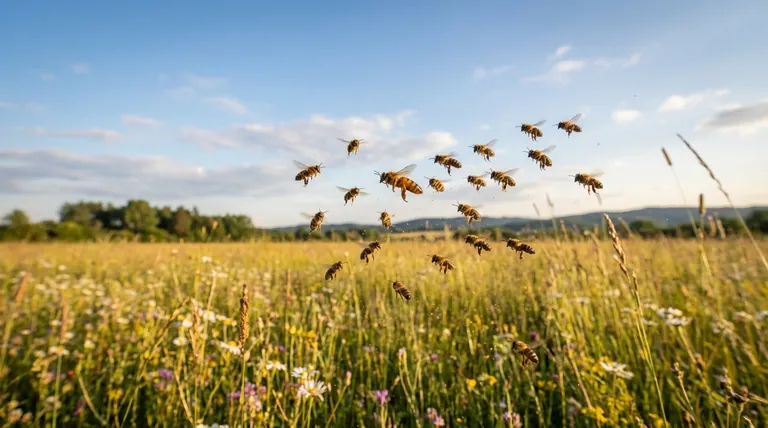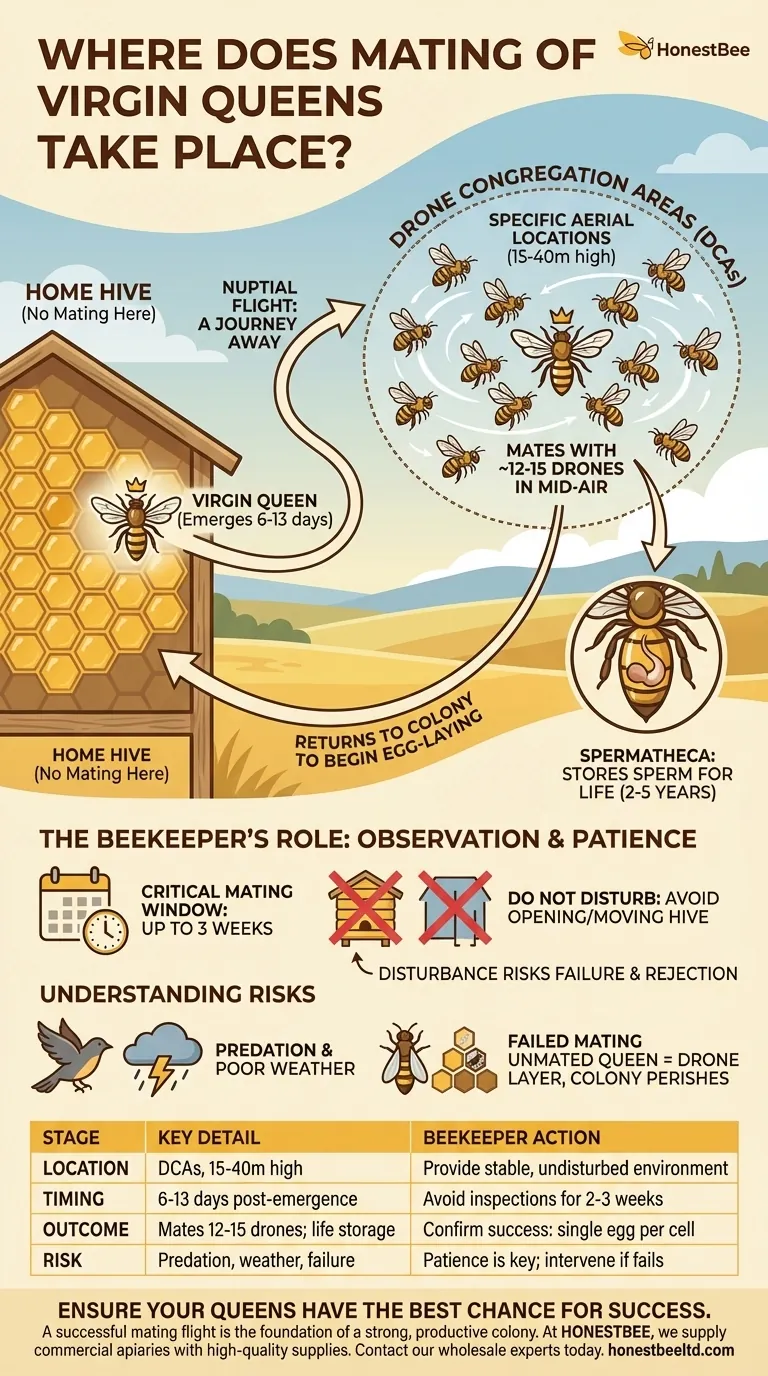The mating of a virgin queen bee takes place exclusively in the open air, far away from the hive. This "nuptial flight" is a deliberate journey to specific aerial locations where she will mate with multiple drones before returning to her colony to begin her life of egg-laying. Mating never occurs inside the hive.
A queen's mating flight is a high-stakes journey to specific locations called Drone Congregation Areas, essential for ensuring genetic diversity. For the beekeeper, understanding this process reveals that the most effective action is inaction; providing a stable, undisturbed hive is paramount to success.

The Mating Flight: A Journey Away From Home
The queen's nuptial flight is one of the most critical events in the life of a honey bee colony. The success of this single journey determines the future health, productivity, and genetic viability of the entire hive.
Why Mating Occurs Outside the Hive
Mating away from the colony is a crucial evolutionary strategy. It ensures the queen mates with drones from other hives, a vital mechanism for promoting genetic diversity and preventing inbreeding. This diversity strengthens the colony's resistance to diseases and improves its overall resilience.
Drone Congregation Areas (DCAs)
These mating flights are not random. They occur in specific, predictable locations known as Drone Congregation Areas (DCAs). Drones from all the colonies in a given region gather at these aerial locations, typically 15 to 40 meters above the ground, waiting for virgin queens to arrive.
The Nuptial Flight Process
A virgin queen will typically embark on her mating flight between 6 and 13 days after emerging. She flies to a DCA where she will mate with an average of 12-15 different drones in mid-air. She stores the collected sperm in a special organ, the spermatheca, which will be sufficient to fertilize millions of eggs for the rest of her life (typically 2-5 years).
The Beekeeper's Role: Observation and Patience
During this critical period, the beekeeper's primary responsibility is to avoid interfering with this natural process. Your patience is the queen's greatest asset.
The Critical Mating Window
The entire mating process, from the queen's emergence to her first egg, can take up to three weeks. The flights themselves usually occur on warm, sunny afternoons.
Why You Must Not Disturb the Hive
Inspecting or moving a hive during the mating period is highly disruptive and one of the most common causes of failure. Do not open or move the hive during this time. Any disturbance can confuse the bees, potentially causing them to reject the queen when she returns from her flight.
Understanding the Risks
The nuptial flight is essential, but it is also fraught with danger. A successful outcome is never guaranteed.
Dangers of the Flight
The queen is vulnerable to predation from birds and dragonflies once she leaves the safety of the hive. Poor weather can also be fatal, as a sudden rainstorm or high winds can prevent her from making it back.
Consequences of a Failed Mating
If a queen is lost on her flight or fails to mate successfully, the colony is in grave danger. An unmated queen will become a "drone layer," only able to lay unfertilized eggs. Without intervention from the beekeeper, a queenless or drone-laying colony will eventually perish.
How to Support a Successful Mating
Your goal is to create an environment that gives your new queen the best possible chance to mate successfully and return safely.
- If your primary focus is maximizing mating success: Do not open, move, or feed the hive for at least two to three weeks after the new queen is expected to emerge.
- If your primary focus is confirming a mated queen: Wait until the mating window has passed (about three weeks post-emergence), then perform a quick inspection looking for the key sign of success: a single egg laid neatly in the bottom-center of the cells.
Trusting this natural process and providing stability is the beekeeper's most powerful tool for building a thriving colony.
Summary Table:
| Stage | Key Detail | Beekeeper Action |
|---|---|---|
| Location | Drone Congregation Areas (DCAs), 15-40m high | Provide a stable, undisturbed hive environment |
| Timing | 6-13 days after emergence; warm, sunny afternoons | Avoid inspections or hive movement for 2-3 weeks |
| Outcome | Mates with 12-15 drones; stores sperm for life | Confirm success by looking for a single egg per cell |
| Risk | Predation, poor weather, failed mating | Patience is key; intervene only if mating fails |
Ensure your queens have the best chance for success. A successful mating flight is the foundation of a strong, productive colony. At HONESTBEE, we supply commercial apiaries and beekeeping equipment distributors with the high-quality, reliable supplies needed to support every stage of the beekeeping lifecycle—from queen rearing to honey harvest. Let us help you build a more resilient operation. Contact our wholesale experts today to discuss your needs.
Visual Guide

Related Products
- Jenter Queen Rearing Kit Complete Set for Bee Breeding
- No Grafting Queen Rearing Kit: System for Royal Jelly Production and Queen Rearing
- Nicot Queen Rearing Kit for Beekeeping and Grafting in Nicot System
- Retractable Chinese Queen Rearing Grafting Tools Equipment
- Plastic Chinese Queen Grafting Tool for Bee Queen Rearing
People Also Ask
- How can beekeepers start a honey bee breeding program? Build a Superior, Resilient Apiary
- What genetic pathways differ in QE-queens? Unlocking the Master Controls of Queen Bee Biology
- What were the size differences among queens reared from worker larvae? Maternal Origin Determines Queen Size
- What is the timeline for queen breeding? A 28-Day Guide from Egg to Laying Queen
- What are the stages involved in queen raising? A Guide to Controlled, High-Quality Queen Production



















